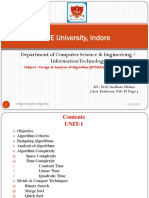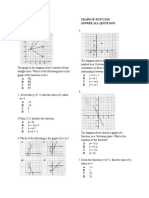Design & Analysis of Algorithm Code: IT501 Contact: 3L + 1T Credits: 4
Uploaded by
Prasenjit DasDesign & Analysis of Algorithm Code: IT501 Contact: 3L + 1T Credits: 4
Uploaded by
Prasenjit DasDesign & Analysis of Algorithm Code: IT501 Contact: 3L + 1T Credits: 4 Complexity Analysis:[2L] Time and Space Complexity, Different
Asymptotic notations their mathematical significance Algortihm Design Techniques: Divide and Conquer: [3L] Basic method, use, Examples Binary Search, Merge Sort, Quick Sort and their complexity Heap Sort and its complexity [1L] Dynamic Programming: [3L] Basic method, use, Examples Matrix Chain Manipulation, All pair shortest paths, single source shortest path. Backtracking: [2L] Basic method, use, Examples 8 queens problem, Graph coloring problem. Greedy Method: [3L] Basic method, use, Examples Knapsack problem, Job sequencing with deadlines, Minimum cost spanning tree by Prims and Kruskals algorithm. Lower Bound Theory: [1L] O(nlgn) bound for comparison sort Disjoint set manipulation: [2L] Set manipulation algorithm like UNION-FIND, union by rank. Graph traversal algorithm: Recapitulation [1L] Breadth First Search(BFS) and Depth First Search(DFS) Classification of edges - tree, forward, back and cross edges complexity and comparison String matching problem: [3L] Different techniques Naive algorithm, string matching using finite automata, and Knuth, Morris, Pratt (KMP) algorithm with their complexities. Amortized Analysis: [3L] Aggregate, Accounting, and Potential Method. Network Flow: [3L] Ford Fulkerson algorithm, Max-Flow Min-Cut theorem (Statement and Illustration) Matrix Manipulation Algorithm: [3L] Strassens matrix manipulation algorithm; application of matrix multiplication to solution of simultaneous linear equations using LUP decomposition, Inversion of matrix and Boolean matrix multiplication Notion of NP-completeness: [3L] P class, NP class, NP hard class, NP complete class their interrelationship, Satisfiability problem, Cooks theorem (Statement only), Clique decision problem Approximation Algorithms: [3L] Necessity of approximation scheme, performance guarantee, polynomial time approximation schemes, vertex cover problem, travelling salesman problem. Text Book: 6. T. H. Cormen, C. E. Leiserson, R. L. Rivest and C. Stein, Introduction to Algorithms 7. A. Aho, J.Hopcroft and J.Ullman The Design and Analysis of Algorithms D.E.Knuth The Art of Computer Programming, Vol. 3 Jon Kleiberg and Eva Tardos, "Algorithm Design" Reference: 11.4 K.Mehlhorn , Data Structures and Algorithms - Vol. I & Vol. 2. 11.5 S.Baase Computer Algorithms 11.6 E.Horowitz and Shani Fundamentals of Computer Algorithms 11.7 E.M.Reingold, J.Nievergelt and N.Deo- Combinational Algorithms- Theory and Practice, Prentice Hall, 1997
Design & Analysis Algorithm Lab Code: IT591 Contact: 3P Credits: 2 Programming Language used :C Lab :1 : Divide and Conquer : > Implement Binary Search using Divide and Conquer approach > Implement Merge Sort using Divide and Conquer approach Lab :2 : Divide and Conquer : > Implement Quick Sort using Divide and Conquer approach > Find Maximum and Minimum element from a array of integer using Divide and Conquer approach Lab :3 : Dynamic Programming : > Find the minimum number of scalar multiplication needed for chain of matrix Lab :4 : Dynamic Programming : >Implement all pair of Shortest path for a graph ( Floyed- Warshall Algorithm ) >Implement Traveling Salesman Problem Lab :5 : Dynamic Programming : >Implement Single Source shortest Path for a graph ( Dijkstra , Bellman Ford Algorithm ) Lab :6 : Brunch and Bound : >Implement 15 Puzzle Problem Lab :7 : Backtracking : >Implement 8 Queen problem Lab :8 : Backtracking (implement any one of the following problem): >Graph Coloring Problem >Hamiltonian Problem Lab :9 : Greedy method(implement any one of the following problem) : >Knapsack Problem >Job sequencing with deadlines Lab :10 : Greedy method (implement any one of the following problem) : >Minimum Cost Spanning Tree by Prim's Algorithm >Minimum Cost Spanning Tree by Kruskal's Algorithm Lab :11 : Graph Traversal Algorithm : >Implement Breadth First Search (BFS) >Implement Depth First Search (DFS)
You might also like
- Unit 4 Fourier Transforms Lecture Notes PDF100% (1)Unit 4 Fourier Transforms Lecture Notes PDF30 pages
- Design & Analysis Algorithm Lab Code: IT591 Contact: 3P Credits: 2 Programming Language Used:cNo ratings yetDesign & Analysis Algorithm Lab Code: IT591 Contact: 3P Credits: 2 Programming Language Used:c1 page
- DAA(Design and Analysis of Algorithm) CSENo ratings yetDAA(Design and Analysis of Algorithm) CSE115 pages
- Dsign and Analysis of Algorithms (R20a0505)No ratings yetDsign and Analysis of Algorithms (R20a0505)117 pages
- ADA - BCS401 MOD 1 (Simplified Notes) @vtunetwork100% (1)ADA - BCS401 MOD 1 (Simplified Notes) @vtunetwork24 pages
- Design and Analysis Algorithms Lecture Notes100% (1)Design and Analysis Algorithms Lecture Notes116 pages
- 2. Course Information Sheet (Theory) AlgoNo ratings yet2. Course Information Sheet (Theory) Algo8 pages
- Design and Analysis of Algorithms (Complete)No ratings yetDesign and Analysis of Algorithms (Complete)116 pages
- Course Outline HCT423 Design and Analysis of AlgorithmsNo ratings yetCourse Outline HCT423 Design and Analysis of Algorithms6 pages
- Design AND Analysis OF Algorithms: K.PALRAJ M.E., (PH.D)No ratings yetDesign AND Analysis OF Algorithms: K.PALRAJ M.E., (PH.D)24 pages
- Cs816: Design and Analysis of Algorithms (Daa) : (Professional Elective-I For M.Tech CSE)No ratings yetCs816: Design and Analysis of Algorithms (Daa) : (Professional Elective-I For M.Tech CSE)1 page
- 01ce0503 Design and Analysis of Algorithm 1No ratings yet01ce0503 Design and Analysis of Algorithm 14 pages
- Cs6402 Design and Analysis of Algorithms Appasami Lecture Notes PDFNo ratings yetCs6402 Design and Analysis of Algorithms Appasami Lecture Notes PDF161 pages
- T7909_Design and Analysis of Algorithms (1)No ratings yetT7909_Design and Analysis of Algorithms (1)3 pages
- DAA Notes Unit II-divide and Conquer (V+ Edition)No ratings yetDAA Notes Unit II-divide and Conquer (V+ Edition)8 pages
- Gujarat Technological University: Master of Computer ApplicationNo ratings yetGujarat Technological University: Master of Computer Application3 pages
- Review Exercises For Chapter 2: Acceleration of The Top of The LadderNo ratings yetReview Exercises For Chapter 2: Acceleration of The Top of The Ladder10 pages
- Study of Linear Transformation and Its ApplicationNo ratings yetStudy of Linear Transformation and Its Application9 pages
- Algebra Through Practice Volume 4 - Blyth T.S., Robertson E.F.0% (1)Algebra Through Practice Volume 4 - Blyth T.S., Robertson E.F.112 pages
- SPECTRAL THEORY AND ITS APPLICATIONS Boo PDFNo ratings yetSPECTRAL THEORY AND ITS APPLICATIONS Boo PDF174 pages
- Chapter 4 Inverse Trigonometric FunctionsNo ratings yetChapter 4 Inverse Trigonometric Functions72 pages
- Structural Graph Theory - Adam Hesterberg - MOP (Blue) 2011No ratings yetStructural Graph Theory - Adam Hesterberg - MOP (Blue) 20112 pages
- Further Maths 3 Revision Notes Feb 2016No ratings yetFurther Maths 3 Revision Notes Feb 201656 pages
- North London Collegiate School Jeju: Mathematics: Analysis and ApproachesNo ratings yetNorth London Collegiate School Jeju: Mathematics: Analysis and Approaches11 pages
- WWW - Manaresults.Co - In: Mathematical Foundations of Computer Science (Com. To CSE, IT, ECC) II B. Tech I SemesterNo ratings yetWWW - Manaresults.Co - In: Mathematical Foundations of Computer Science (Com. To CSE, IT, ECC) II B. Tech I Semester4 pages
- Topical Exercise Paper 1 (40 Marks) Graph of Function Answer All Questions100% (1)Topical Exercise Paper 1 (40 Marks) Graph of Function Answer All Questions6 pages

























































































